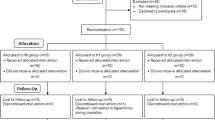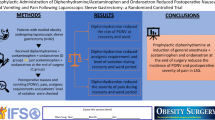Abstract
Background
Many patients may experience postoperative nausea and vomiting (PONV) following laparoscopic sleeve gastrectomy (LSG). We evaluated the efficacy of the combination of haloperidol, dexamethasone, and ondansetron for prevention of PONV after LSG.
Methods
Ninety patients were included in this prospective, randomized, double-blinded, three-arm study (group O: ondansetron 8 mg; group DO: dexamethasone 8 mg and ondansetron 8 mg; group HDO: haloperidol 2 mg, dexamethasone 8 mg, and ondansetron). Nausea, vomiting, rescue antiemetic use, morphine consumption, adverse events, and volume of intravenous fluids infused were recorded at regular intervals for 36 h postoperatively.
Results
The incidence of nausea was lower 0–2 h postoperatively in group HDO compared to group O (23.7 versus 56.7 %, p = 0.016) and at 12–24 h postoperatively was lower in group HDO (23.3 %) and group DO (26.7 %) compared to group O (60 %) (p = 0.008 and p = 0.009, respectively). At 0–36 h postoperatively, nausea was lower in group HDO compared to group O (53.3 versus 86.7 %, p = 0.013). Vomiting at 0–36 h postoperatively was lower in group HDO compared to group O (20 versus 53.3 %, p = 0.015). Rescue antiemetic drug and morphine consumption were less used in group HDO compared to group O (p <0.01). The volume of fluids infused in group O was approximately 1 l greater than in group HDO (p = 0.026).
Conclusion
The combination of haloperidol, dexamethasone, and ondansetron reduced PONV and the necessity of rescue antiemetics and also reduced morphine consumption and the volume of fluids infused postoperatively.





Similar content being viewed by others
References
Brethauer SA, Hammell JP, Schauer PR. Systematic review of sleeve gastrectomy as staging and primary bariatric procedure. Surg Obes Relat Dis. 2009;5:469–75.
Keidar A, Appelbaum L, Schweiger C, et al. Dilated upper sleeve can be associated with severe postoperative gastroesophageal dysmotility and reflux. Obes Surg. 2010;20(2):140–7.
Lazoura O, Zacharoulis D, Triantafyllidis G, et al. Symptoms of gastroesophageal reflux following laparoscopic sleeve gastrectomy are related to the final shape of the sleeve as depicted by radiology. Obes Surg. 2011;21(3):295–9.
Mayeur C, Robin E, Kipnis E, et al. Impact of a prophylatic strategy on the incidence of nausea and vomiting after general surgery. Ann Fr Anesth Reanim. 2012;31(2):e53–7.
Kerger H et al. Patients' willingness to pay for anti-emetic treatment. Acta Anaesthesiol Scand. 2007;51(1):38–43.
Jokinen J, Smith AF, Roewer N, et al. Management of postoperative nausea and vomiting: how to deal with refractory PONV. Anesthesiol Clin. 2012;30(3):481–93.
Eberhart LH, Mauch M, Morin AM, et al. Impact of a multimodal anti-emetic prophylaxis on patient satisfaction in high-risk patients for postoperative nausea and vomiting. Anaesthesia. 2002;57:1022–7.
Pan PH, Lee SC, Harris LC. Antiemetic prophylaxis for postdischarge nausea and vomiting and impact on functional quality of living during recovery in patients with high emetic risks: a prospective, randomized, double-blind comparison of two prophylactic antiemetic regimens. Anesth Analg. 2008;107:429–38.
Parra-Sanches I, Abdallah R, You J, et al. A time-motion economic analysis of postoperative nausea and vomiting in ambulatory surgery. Can J Anaesth. 2012;59(4):366–75.
Habib AS, Chen Y, Taguchi A, et al. Postoperative nausea and vomiting following inpatient surgeries in a teaching hospital: a retrospective database analysis. Curr Med Res Opin. 2006;22:1093–9.
Dilorio TM, Sharkey PF, Hewitt AM, et al. Antiemesis after total joint arthroplasty: does a single preoperative dose of aprepitant reduce nausea and vomiting? Clin Orthop Relat Res. 2010;468:2405–9.
Dzwonczyk R, Weaver TE, Puente EG, et al. Postoperative nausea and vomiting prophylaxis from an economic point of view. Am J Ther. 2010;10:1–5.
Moussa AA, Oregan PJ. Prevention of postoperative nausea and vomiting in patients undergoing laparoscopic bariatric surgery—granisetron alone vs granisetron combined with dexamethasone/droperidol. M.E. J Anesth. 2007;19(2):367–8.
Mendes MN, Monteiro RS, Cruz Martins FAN. Prophylaxis of postoperative nausea and vomiting in morbidly obese patients undergoing laparoscopic gastroplasties: a comparative study among three methods. Rev Bras Anestesiol. 2009;59(5):570–6.
Apfel CC, Laara E, Koivuranta M, et al. A simplified risk score for predicting postoperative nausea and vomiting: conclusions from cross-validations between two centers. Anesthesiology. 1999;91:693–700.
Le TP, Gan TJ. Update on the management of postoperative nausea and vomiting and postdischarge nausea and vomiting in ambulatory surgery. Anesthesiol Clin. 2010;28:225–49.
Apfel CC, Heidrich FM, Jukar-Rao S, et al. Evidence-based analysis of risk factors for postoperative nausea and vomiting. Br J Anaesth. 2012;109(5):742–53.
Apfel CC, Korttila K, Abdalla M, et al. A factorial trial of six interventions for the prevention of postoperative nausea and vomiting. N Engl J Med. 2004;350:2441–51.
Gan TJ, Sinha AC, Kovac AL, et al. A randomized, double-blind, multicenter trial comparing transdermal scopolamine plus ondansetron to ondansetron alone for the prevention of postoperative nausea and vomiting in the outpatient setting. Anesth Analg. 2009;108:1498–504.
Chu CC, Shieh JP, Tzeng JI, et al. The prophylactic effect of haloperidol plus dexamethasone on postoperative nausea and vomiting in patients undergoing laparoscopically assisted vaginal hysterectomy. Anesth Analg. 2008;106:1402–6.
Wang P-K, Tsay P-J, Huang C-C, et al. Comparison of dexamethasone with ondansetron or haloperidol for prevention of patient-controlled analgesia-related postoperative nausea and vomiting: a randomized clinical trial. World J Surg. 2012;36:775–81.
Carlise JB, Stevenson CA. Drugs for preventing postoperative nausea and vomiting. Cochrane Database Syst Rev. 2006;3, CD004125.
Grecu L, Bittner EA, Kher J. Haloperidol plus ondansetron versus ondansetron alone for prophylaxis of postoperative nausea and vomiting. Anesth Analg. 2008;106:1410–3.
Munro AJ, Long GT, Sleigh JW. Nurse-administered subcutaneous morphine is a satisfactory alternative to intravenous patient-controlled analgesia morphine after cardiac surgery. Anesth Analg. 1998;87:11–5.
Weingarten TN, Sprung J, Flores A, et al. Opioid requirements after laparoscopic bariatric surgery. Obes Surg. 2011;21:1407–12.
Edwards J, Meseguer F, Faura C, et al. Single dose dipyrone for acute postoperative pain. Cochrane Database Syst Rev. 2010;9, CD003227.
De Oliveira Jr GS, Agarwal D, Benzon HT. Perioperative single dose ketorolac to prevent postoperative pain: a meta-analysis of randomized trials. Anesth Analg. 2012;114(2):424–33.
De Oliveira Jr GS, Almeida MD, Benzon HT. Perioperative single dose systemic dexamethasone for postoperative pain: a meta-analysis of randomized controlled trials. Anesthesiology. 2011;115:575–88.
Fujii Y, Itakura M. Reduction of postoperative nausea, vomiting, and analgesic requirement with dexamethasone for patients undergoing laparoscopic cholecystectomy. Surg Endosc. 2010;24:692–6.
Grover VK, Mathew PJ, Hegde H. Efficacy of orally disintegrating ondansetron in preventing postoperative nausea and vomiting after laparoscopic cholecystectomy: a randomised, double-blind placebo controlled study. Anaesthesia. 2009;4(6):595–600.
Buttner M, Walder B, von Elm E, et al. Is low-dose haloperidol a useful antiemetic? A meta-analysis of published and unpublished randomized trials. Anesthesiology. 2004;101:1454–63.
Karanicolas PJ, Smith SE, Kanbur B, et al. The impact of prophylactic dexamethasone on nausea and vomiting after laparoscopic cholecystectomy. A systematic review and meta-analysis. Ann Surg. 2008;248:751–62.
White PF, O’Hara JF, Roberson CR. The impact of current antiemetic practices on patient outcomes: a prospective study on high-risk patients. Anesth Analg. 2008;107:452–8.
Habib AS, White WD, Eubanks S, et al. A randomized comparison of a multimodal management strategy versus combination antiemetics for the prevention of postoperative nausea and vomiting. Anesth Analg. 2004;99:77–81.
Acknowledgments
We thank BioMed Proofreading for English correction and copy editing of this manuscript.
We also thank Dr. Maria da Dores Gonçalves da Silva, Dr. Marcondes Costa Marques, and Dr. Juliano Blanco Canavarros and Hospital Jardim Cuiabá for the important assistance in this study.
Conflict of Interest
The authors declare no conflict of interest.
Author information
Authors and Affiliations
Corresponding author
Rights and permissions
About this article
Cite this article
Benevides, M.L., Oliveira, S.S.d.S. & de Aguilar-Nascimento, J.E. The Combination of Haloperidol, Dexamethasone, and Ondansetron for Prevention of Postoperative Nausea and Vomiting in Laparoscopic Sleeve Gastrectomy: a Randomized Double-Blind Trial. OBES SURG 23, 1389–1396 (2013). https://doi.org/10.1007/s11695-013-0923-1
Published:
Issue Date:
DOI: https://doi.org/10.1007/s11695-013-0923-1




